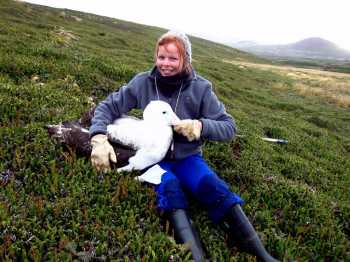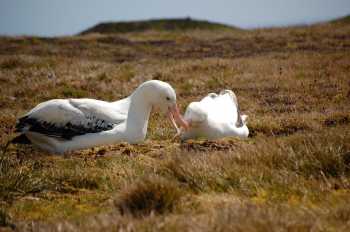The 2011 census of incubating Wandering Albatrosses Diomedea exulans on South Africa's Marion Island was successfully completed over the period 24 January to 18 February, continuing a series of whole-island counts that begun on annual basis in the mid 1980s.
Counts this year were undertaken by the all-woman team of Mia Cerfonteyn, Linda Clokie and Yolokasi Galada, working for a project jointly managed by the Percy FitzPatrick Institute, University of Cape Town and Branch Oceans & Coasts of the Department of Environmental Affairs.

A total of 1711 incubating birds was counted in the 23 standard count areas, a figure similar to recent counts but somewhat more than in earlier years (Ryan et al. 2009). The Wanderers of Marion represent about 20% of the species' global population. Nearby Prince Edward Island, although a smaller island, supports similar numbers, so the island group is home to about 40% of the total population.
During the census three birds bearing French bands were found. French-banded Wanderers come from the Crozet Islands, a thousand kilometres to the east. Movements of Wandering Albatrosses between the two island groups have been regularly reported in small numbers, with a total of 57 individual birds recorded up to 2003 (Cooper & Weimerskirch 2003). Nineteen of these birds were banded as fledglings on one island group and had been found breeding on the other, representing a genuine exchange; nearly all (18) of these exchange birds had moved to the west from the Crozets to the Prince Edwards.
In three of the count areas, breeding birds are followed more intensively throughout the season, with their nests staked and metal and colour bands used to identify partners. This year 257 occupied nests (15% of the island's total count) are being followed in a long-term demographic study that also dates back to the 1980s.

References:
Ryan, P.G., Jones, M.G.W., Dyer, B.M., Upfold, L. & Crawford, R.J.M. 2009. Recent population estimates and trends in numbers of albatrosses and giant petrels breeding at the sub-Antarctic Prince Edward Islands. African Journal of Marine Science 31: 409-471.
Cooper, J. & Weimerskirch, H. 2005. Exchange of the Wandering Albatross Diomedea exulans between the Prince Edward and Crozet Islands: implications for conservation. African Journal of Marine Science 25: 519-523.
With thanks to Mia Cerfonteyn for information.
John Cooper, ACAP Information Officer, 22 February 2011

 English
English  Français
Français  Español
Español